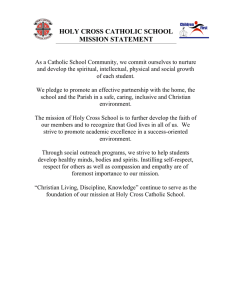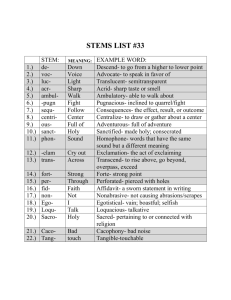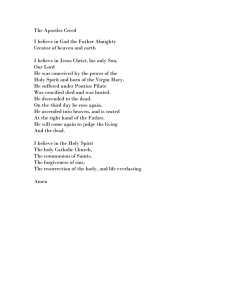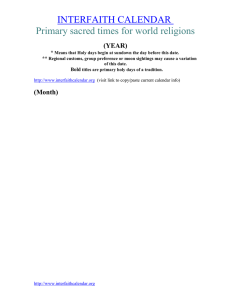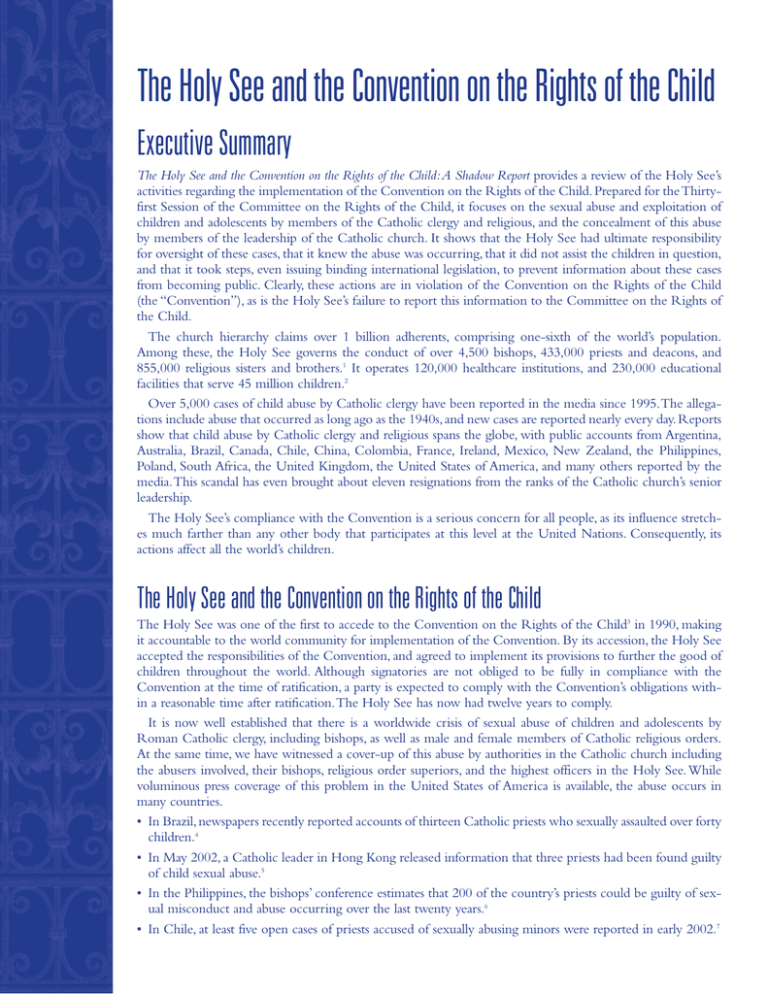
The Holy See and the Convention on the Rights of the Child
Executive Summary
The Holy See and the Convention on the Rights of the Child:A Shadow Report provides a review of the Holy See’s
activities regarding the implementation of the Convention on the Rights of the Child. Prepared for the Thirtyfirst Session of the Committee on the Rights of the Child, it focuses on the sexual abuse and exploitation of
children and adolescents by members of the Catholic clergy and religious, and the concealment of this abuse
by members of the leadership of the Catholic church. It shows that the Holy See had ultimate responsibility
for oversight of these cases, that it knew the abuse was occurring, that it did not assist the children in question,
and that it took steps, even issuing binding international legislation, to prevent information about these cases
from becoming public. Clearly, these actions are in violation of the Convention on the Rights of the Child
(the “Convention”), as is the Holy See’s failure to report this information to the Committee on the Rights of
the Child.
The church hierarchy claims over 1 billion adherents, comprising one-sixth of the world’s population.
Among these, the Holy See governs the conduct of over 4,500 bishops, 433,000 priests and deacons, and
855,000 religious sisters and brothers.1 It operates 120,000 healthcare institutions, and 230,000 educational
facilities that serve 45 million children.2
Over 5,000 cases of child abuse by Catholic clergy have been reported in the media since 1995.The allegations include abuse that occurred as long ago as the 1940s, and new cases are reported nearly every day. Reports
show that child abuse by Catholic clergy and religious spans the globe, with public accounts from Argentina,
Australia, Brazil, Canada, Chile, China, Colombia, France, Ireland, Mexico, New Zealand, the Philippines,
Poland, South Africa, the United Kingdom, the United States of America, and many others reported by the
media.This scandal has even brought about eleven resignations from the ranks of the Catholic church’s senior
leadership.
The Holy See’s compliance with the Convention is a serious concern for all people, as its influence stretches much farther than any other body that participates at this level at the United Nations. Consequently, its
actions affect all the world’s children.
The Holy See and the Convention on the Rights of the Child
The Holy See was one of the first to accede to the Convention on the Rights of the Child3 in 1990, making
it accountable to the world community for implementation of the Convention. By its accession, the Holy See
accepted the responsibilities of the Convention, and agreed to implement its provisions to further the good of
children throughout the world. Although signatories are not obliged to be fully in compliance with the
Convention at the time of ratification, a party is expected to comply with the Convention’s obligations within a reasonable time after ratification.The Holy See has now had twelve years to comply.
It is now well established that there is a worldwide crisis of sexual abuse of children and adolescents by
Roman Catholic clergy, including bishops, as well as male and female members of Catholic religious orders.
At the same time, we have witnessed a cover-up of this abuse by authorities in the Catholic church including
the abusers involved, their bishops, religious order superiors, and the highest officers in the Holy See. While
voluminous press coverage of this problem in the United States of America is available, the abuse occurs in
many countries.
• In Brazil, newspapers recently reported accounts of thirteen Catholic priests who sexually assaulted over forty
children.4
• In May 2002, a Catholic leader in Hong Kong released information that three priests had been found guilty
of child sexual abuse.5
• In the Philippines, the bishops’ conference estimates that 200 of the country’s priests could be guilty of sexual misconduct and abuse occurring over the last twenty years.6
• In Chile, at least five open cases of priests accused of sexually abusing minors were reported in early 2002.7
2
c atholics for a free choice
• In January 2002, several religious orders in Ireland agreed
to pay $110 million (USD) to people who, as children, had
suffered physical and sexual abuse in schools and child care
institutions run by the Catholic church.8
• Since 1995, thirty priests in France have been convicted of
sexual abuse; twenty-one similar cases were reported in
Britain between 1995 and 1999, and between 1994 and
2001 in Germany, there were thirteen cases.9
The shadow report examines whether the Holy See has
utilized its law, policies, and practice to uphold the
Convention, or whether it has neglected its duties to protect
and promote the rights of children throughout the world,
thereby violating the Convention to which it acceded. It also
considers whether the Holy See has interfered in other states’
compliance with the Convention by promoting disregard for
civil laws designed to protect children, such as reporting child
sexual abuse. Insofar as possible, this presentation responds to
the assertions in the Holy See’s 1994 report, and addresses
compliance with the Convention by appealing to the legislation of the Holy See and its dependent governing and executive bodies, examples of policy and practice of the Roman
Catholic church, media sources, and independent research.
Statements of the Holy See
As stated in its report to the Committee in 1994, the Holy
See has unequivocally affirmed the rights of the child through
various documents and statements. From promoting the life,
dignity, and rights of the child, to vocally defending and supporting the Convention, the Holy See has issued official statements, teachings and even a Charter of the Rights of the
Family to affirm the rights and well-being of children.10 Since
the scandal of clerical sexual abuse has become public, the
Holy See has rightly put forth statements decrying the actions
of these priests.11 However poignant and emotional, the statements themselves do not demonstrate the commitment
required by States parties to the Convention. For evidence of
full commitment and compliance with the Convention, one
must look to the actions of the party and its processes
designed to deal with the abuse.
Law of the Holy See
The Code of Canon Law (the “code”) provides the legal
underpinning not only for the fundamental legislation of the
Vatican City State,12 but it also spells out the constitutive and
disciplinary scheme of the Roman Catholic church and is
applicable to all members throughout the world. In this law,
and by its own declaration, the Holy See governs the Catholic
church.13 Canon law has several sections that illustrate recognition of some rights of the child and repugnance for sexual
abuse of children by clergy and religious.
The code makes several assertions of basic rights that are
applicable to the protection and defense of children. A few
examples of these rights demonstrate that all subjects have the
right under the law to express their needs to their local
authorities, the bishops.14 The rights to privacy and to maintain one’s good reputation are also enumerated.15 The code
also states clearly that Christians have the right to defend their
rights (these and others) in a competent church forum, in
accord with the law.16
The code provides a detailed judicial process to investigate,
confirm or repudiate claims, and punish clergy sexual abuse
of minors, which is defined as a criminal act. 17 It even prescribes a penalty for negligence, which could be asserted in
these cases when a superior has failed to investigate or punish
instances of actionable offenses brought to his attention.
Responsibility for handling cases of clerical sexual abuse of
children usually lies first with the diocesan bishop, and ultimately with the Holy See.18
In 2001, the Holy See issued a little-publicized but important change in the law, in which the Holy See directs all the
bishops of the world to inform one of its offices, the
Congregation for the Doctrine of the Faith, if they receive an
allegation of child sexual abuse by a cleric.19 This same law
prohibits the bishops or other church authorities from taking
any action beyond a preliminary investigation of the allegation without further direction from the Holy See’s delegate,
and subjects all these cases to “the pontifical secret.”20
The church’s own laws have been consistently ignored,
inadequately applied, or wrongly applied by its authorities in
favor of its institutional image. In the following section, this
report investigates how the Holy See has failed to enforce its
legislation, failed to support its assertions in defense of children, and failed to implement the Convention.
Holy See and Church structures dealing
with children
The Holy See, in its 1994 report, recognizes the “extensive
network of institutions” on many levels through which it
intervenes on behalf of children. It delineates structures at the
level of the Holy See that operate on the international stage,
including, for example, the Pontifical Council for the Family
and the International Catholic Child Bureau.21 These are in
addition to the governmental bodies (called “curial offices”)
at the Holy See that can intervene in cases of clerical abuse of
children.
The Holy See’s claims in this section of its report again
illustrate its recognition that children, as vulnerable individuals in our society, need special protections and even special
establishments or associations dedicated to their concerns.
The Holy See joined several states in the following forceful
statement after an international meeting sponsored by the
Pontifical Council on the Family:“Every abuse against [children’s] dignity is a crime against humanity . . . we pledge to
t h e h o ly s e e a n d t h e c o n v e n t i o n o n t h e r i g h t s o f t h e c h i l d
respond.”22 The next section of this report examines whether
the Holy See has lived up to its pledge.
Implementation of the Convention
The report shows that there are legal measures present for the
Holy See to implement the rights recognized in the
Convention.What is lacking is a utilization of these provisions
in favor of the child. Allegations of abuse have been leveled
against priests and bishops throughout the world.
Between 1993 and June 2002, eleven bishops around the
world resigned amid allegations of sexual abuse, or cover-ups
of abuse. These resignations come from Austria, Australia,
Canada, Ireland, Poland, the United Kingdom, and the
United States of America. There is no reporting available of
bishops who have followed the Holy See’s laws regarding
these cases. Rather, there is instance after instance of abusive
priests being moved between parishes, of some being sent for
psychological evaluation and treatment only to be returned to
situations where they abused children again, and of diocesan
bishops entering into monetary settlements on conditions
of secrecy.
Given the evidence of a longstanding problem of clergy
and religious sexual abuse around the world, it is troubling
that the Holy See omitted any mention of the crisis in its
1994 report to the Committee.There is no indication that the
church authorities have utilized the provisions of secular or
ecclesiastical law, nor that the Holy See encouraged compliance with its own law or with the Convention even though
officials of the Holy See were acutely aware of the problem.
The only conclusion to be drawn is that the Holy See has
been at least willfully ignorant, if not culpably negligent, in
regard to sexual abuse of children by its representatives, preferring instead to maintain an institutional silence at the peril
of those very children they purport to protect under the aegis
of their mission, law and the provisions of the Convention on
the Rights of the Child.
The Holy See is in clear violation of Article 19 of the
Convention. This article requires States parties to “take all
appropriate legislative, administrative, social, and educational
measures to protect the child from sexual abuse [from] any
person who has care of the child.”The Holy See has further
compounded the problem by failing to report to civil authorities instances of child abuse by its clergy and religious, and by
failing to follow up on future activities of the abusers. This
activity compounds the difficulties for other States parties
attempting to implement the Convention, when the Holy
See overtly contravenes civil law and policy designed to protect children and punish those who would harm them. The
examples in this report, as well as those included in the
annexes provide incontrovertible substantiation for this claim.
The Catholic church is internationally recognized as a
major health care provider.The Holy See claims that under its
umbrella, Catholic organizations and agencies operate roughly 120,000 healthcare institutions throughout the world.23
Through these institutions, great strides have been made
for children’s health; nonetheless, the Holy See has also put
children’s health at grave risk due to sexual abuse.
The sexual abuse of a child is undoubtedly harmful to that
child and distorts the child’s normal psychological development. It often results in serious short- and long-term negative
effects on the child, his or her family, and community.24 The
leaders of the Catholic church have perpetuated the risk to
children by allowing men who have abused children and
those who have been credibly accused of abusing children, to
continue to work, sometimes placing them as chaplains in
these very healthcare institutions which should be dedicated
to improving children’s lives, and which should have protections in place to prevent child abusers from working there.25
In its failure to provide adequate protections for children in
these institutions, and in its negligence in removing abusive
priests from the priesthood, the Holy See has failed to uphold
the provisions of these articles of the Convention that ensure
the right of every child to a standard of living adequate
for the child’s physical, mental, spiritual, moral and social
development.
Recommendations
The report offers recommendations for action to various
bodies involved or concerned with the Convention on the
Rights of the Child, and with the Holy See’s fulfillment of its
obligations under the Convention. Recommendations are
offered to the Holy See itself, to the UN Committee on the
Rights of the Child, to UNICEF, to other UN Member
States, and to interested NGOs.
Conclusion
The shadow report presents a sketch of the problem of child
sexual abuse by Catholic clergy and religious throughout the
world. It shows the ways in which the law of the party, the
Holy See, addresses the issue of child abuse by clergy—condemning the act, but at the same time failing to follow
through on punishing abusers, and now even obstructing the
justice system in other territories by mandating institutional
secrecy about the issue.While media reporting of this abuse is
uneven throughout the world, there can be no doubt that this
is truly a global crisis, and with the mobility of peoples every
state should be concerned that abusers will present themselves
as religious leaders in their midst.We urge the Committee to
take up the serious task of calling the Holy See to account for
perpetrating and perpetuating this crisis.
3
4
c atholics for a free choice
Endnotes
13
Codex Iuris Canonici (Code of Canon Law), canon 331.
14
Codex Iuris Canonici, canon 212§2.
1
15
Ibid., canon 218.
16
Codex Iuris Canonici, canon 221§1.This forum is separate from those provided by civil society.The canon refers to an independent ecclesiastical
court or alternate venue for redress of rights.
17
Codex Iuris Canonici, canon 1395§2.
18
Office of the High Commissioner on Human Rights, Convention on the
Rights of the Child, adopted and opened for signature, ratification and
accession by General Assembly resolution 44/25, November 20, 1989,
<http://www.unhchr.ch/html/menu3/b/k2crc.htm> (cited 9 Aug. 2002),
Article 1.
For priests in religious institutes and societies of apostolic life, the superior
of the institute or society often has primary responsibility, although there is
sometimes overlap with the diocesan bishop’s competence.
19
Debora Crivellaro and Thiago Cordeiro,“O Sexo dos Anjos,” Revista Epoca,
January 21, 2002;“Igreja,” Revista Epoca, January 21, 2002;“Revelações
Perigosas da Igreja no Brasil,” Folha de Sao Paulo, April 25, 2002; Marcos
Sergio Silva,“Sexo e Religião: Em Franca (SP), Bispo Revela que
Sacerdote Confessou Ter Tido um Caso Com Menor e Que Pretende
Seguir na Igreja,” Folha de Sao Paulo, April 25, 2002; Correa Neves Junior,
“Padres, Irmãos. Acusados de Engravidar Jovens,” Lux Jornal, April 27,
2002; Evaldo Magalhaes,“Cúria Afasta Padre Acusado de Pedofilia,” Lux
Jornal, May 4, 2002; Daniela Vianna,“Prisão de Padre Flagrado com Menor
Choca Pacata Corumbataí,” Lux Jornal, May 6, 2002; Christopher K. Hepp,
“Mystery of Abuser Priest Follows Him from Philadelphia to Brazil,”
Philadelphia Inquirer, May 18, 2002.
John Paul II, Apostolic Letter motu proprio, Sacramentorum sanctitatis tutela,
April 30, 2001, sent by letter of the Congregation for the Doctrine of the
Faith to all Catholic bishops in the world on May 18, 2001 (Epistula ad
totius Catholicae Ecclesiae Episcopos aliosque Ordinarios et Hierarchas interesse
habentes de <<delictis gravioribus>> eidem Congregationi pro Doctrina Fidei<<
reservatis>>),Acta Apostolicae Sedis 93 (2001) 737–739 and 785–788 respectively. See <http://www.vatican.va/roman_curia/congregations/
cfaith/doc_dis_index.htm>.
20
The Congregation for the Doctrine of the Faith (commonly abbreviated
CDF), founded in 1542 by Pope Paul III, is one of the departments of the
Vatican that assists the pope in governing the Catholic church. It was originally called the Sacred Congregation of the Universal Inquisition, as its
duty was to defend the church from heresy. It is the oldest of the Curia’s
nine congregations.The congregation, says the “Activity of the Holy See,”
in conformity with its raison d’etre, promotes in a collegial fashion encounters and initiatives to “spread sound doctrine and defend those points of
Christian tradition which seem in danger because of new and unacceptable
doctrines.” See the Vatican website <http://www.vatican.va>.
21
Holy See Report, 1994, 19–21.
22
Holy See Report, 1994, 50 and Annex 24: Final declaration of the
International Meeting on the Sexual Exploitation of Children through
Prostitution and Pornography, held in Bangkok, 9–11 September 1992.
23
Holy See report to the United Nations Children’s Fund, Prot.
No. 21205/00, December 5, 2000, sect. D(b).
24
For a concise summary of known effects of child abuse, as well as references
to other sources, see Health Canada,“The Consequences of Child
Maltreatment: A Reference Guide for Health Practitioners,”
<http://www.hc-sc.gc.ca/hppb/familyviolence/html/98p057e3.html>;
and the U.S. Department of Health and Human Services’ National
Clearinghouse on Child Abuse and Neglect Information, at
<http://www.calib.com/nccanch/index.cfm>.
25
Jeff Tiernan,“Priest scandal hits hospitals,” Modern Healthcare, May 13, 2002.
2
3
4
Vatican Information Service, May 5, 2002.
Holy See report to the United Nations Children’s Fund,“National
Programme Review of the Holy See on the implementation of the
Convention on the Rights of the Child and the World Declaration and
Plan of Action for the World Summit for Children,” Prot. No. 21205/00,
December 5, 2000.
5
“3 Catholic Priests Abused Hong Kong Children,” Reuters, May 2, 2002.
6
“Philippine Bishops Apologize For Sexual Abuse by Priests,” Washington
Post, July 9, 2002.
7
Michael Paulson,“World Doesn’t Share US View of Scandal,” Boston Globe,
April 8, 2002.
8
Brian Lavery,“Religious Orders Offer $110 Million to Irish Sex Abuse
Victims,” New York Times, February 1, 2002.
9
John Tagliabue,“Europe has problems, but not like America’s. Maybe.” New
York Times, April 21, 2001.
10
Holy See Report, 1994, 17.
11
John Paul II,“Holy Thursday Address to Priests: Ministers of Mercy: the
Sacrament of Reconciliation,” Origins 31, no. 42 (April 4, 2002): 694-699;
John Paul II,“Address to Summit of Vatican, U.S. Church Leaders,” Origins
31, no.46 (May 2, 2002): 758–759; John Paul II, Statement to Nigerian
Bishops, April 30, 2002, Origins 31, no.46 (May 2, 2002): 764.
12
La Nuova Legge Fondamentale Dello Stato Della Città Del Vaticano, effective
February 22, 2000. Can be found on the World Wide Web at
<www.vatican.va>.
The full report is available from Catholics for a Free Choice.
The Holy See and the Convention on the Rights of the Child:A Shadow Report
ISBN #0-915365-43-X
© 2002 Catholics for a Free Choice. All Rights Reserved. Published 2002.
Catholics for a Free Choice (CFFC) is a non-governmental organization with special consultative status with the Economic and Social
Council (ECOSOC) of the United Nations. Catholics for a Free Choice shapes and advances sexual and reproductive ethics that are
based on justice, reflect a commitment to women’s well-being, and respect and affirm the moral capacity of women and men to make
sound decisions about their lives.Through discourse, education and advocacy, CFFC works in the United States and internationally to
infuse these values into public policy, community life, feminist analysis, and Catholic social thinking and teaching.
Catholics for a Free Choice
1436 U Street, NW Suite 301
Washington, DC 20009 USA
Phone: +1 (202) 986-6093 Fax: +1 (202) 332-7995
Email: cffc@catholicsforchoice.org URL: www.catholicsforchoice.org
C Printed on recycled paper

